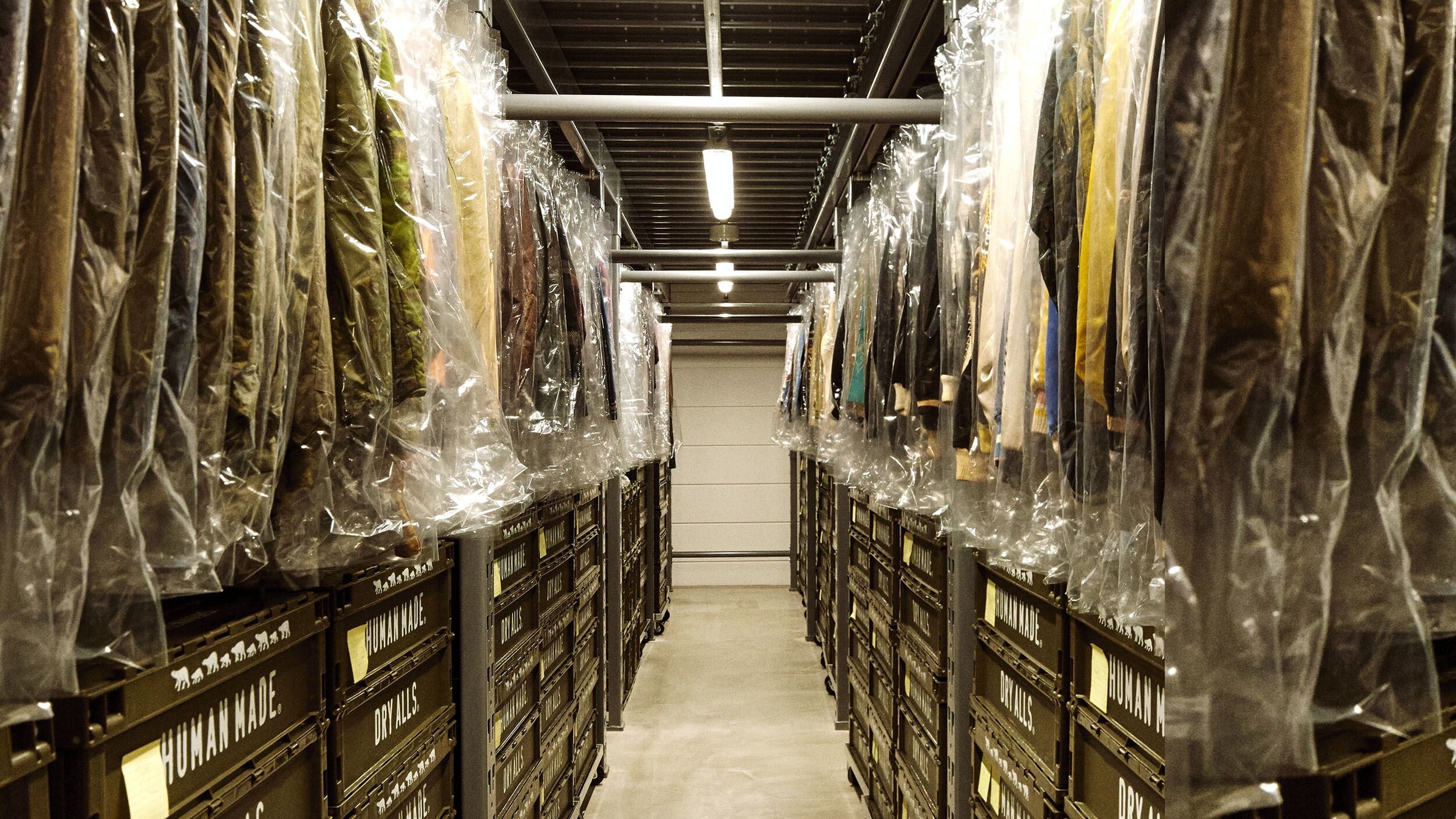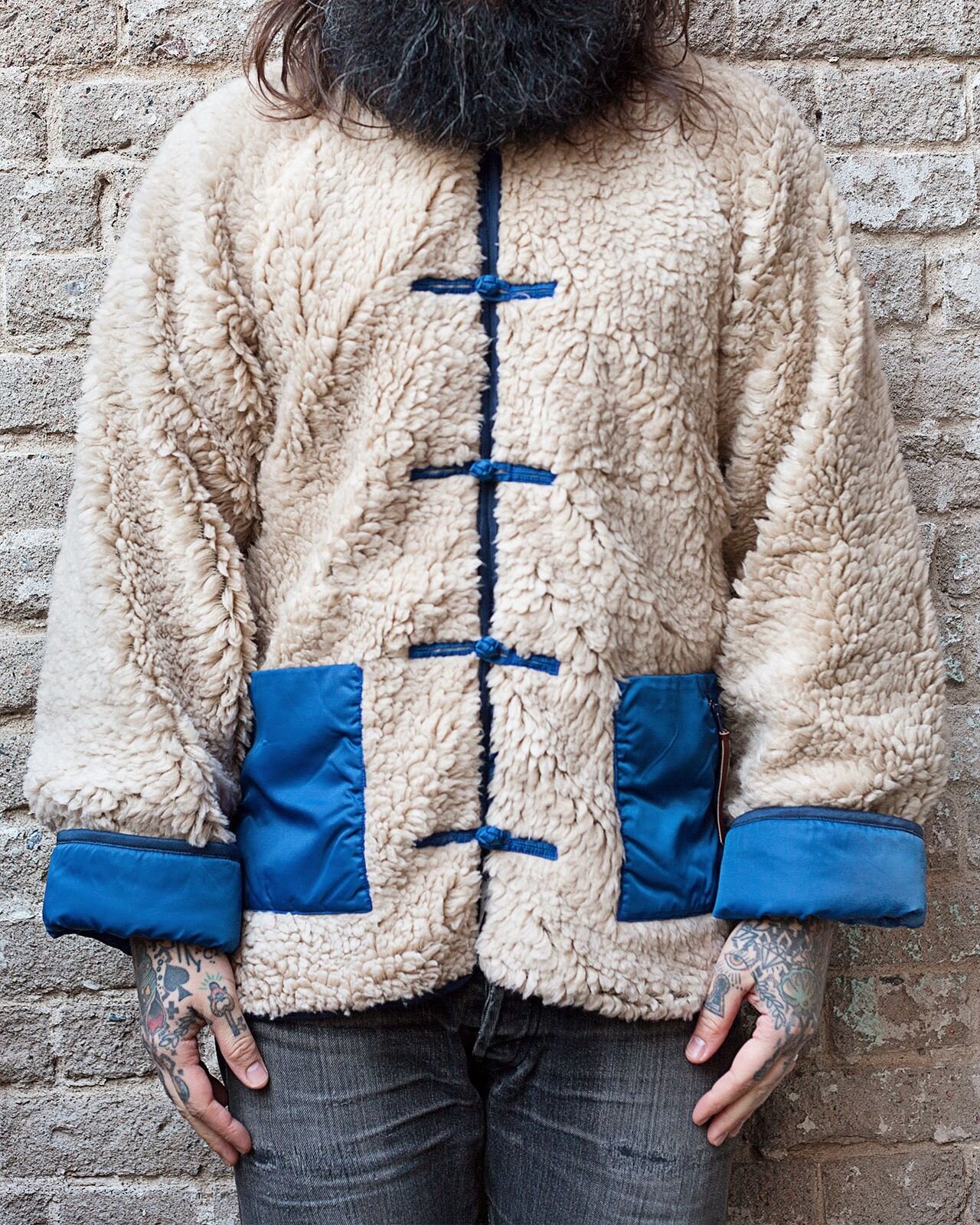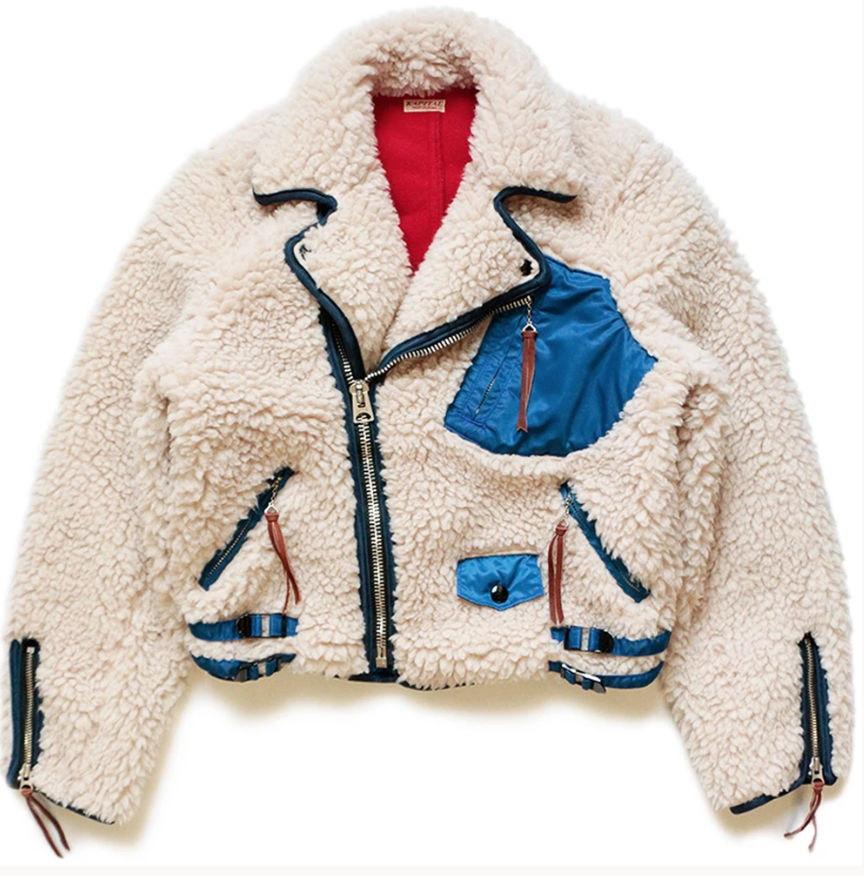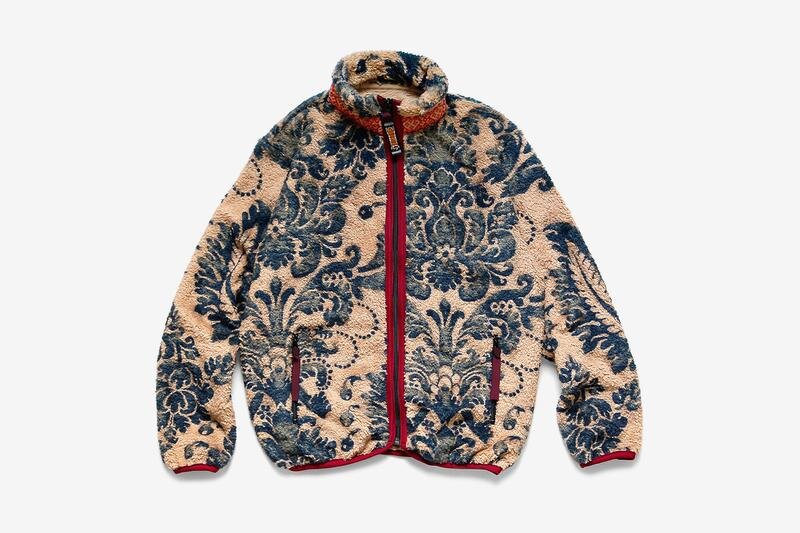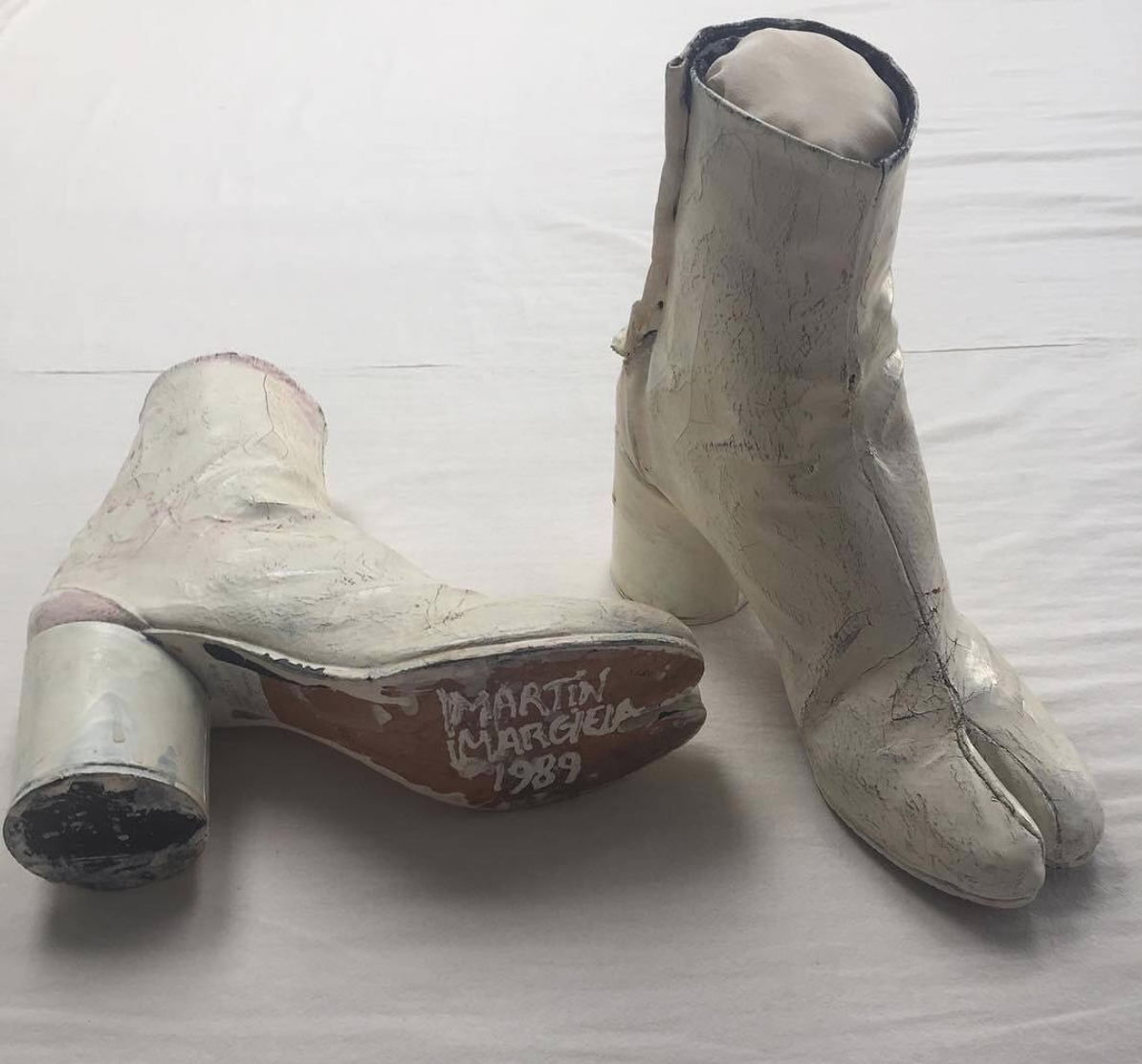Archive Fashion: A Remedy for Today's Throwaway Streetwear Scene
The rise of archive fashion might play a surprisingly significant role as the fashion world enters a new decade.
Nigo’s Streetwear Archive in Tokyo (Image: Complex)
My father bought an olive-green trench coat while he was living in Helsinki in the 80s. It was used by my father for quite some time after being thrown up into our attic of my family home in upper Pirkanmaa. At the end of last summer, my peeps were going through the stuff that had been laying around there for years and they found the coat. When they showed me the jacket, I liked the ascetic color and the oversized fit instantly. I was fascinated with the distinctive design so I did some research about the brand and designer of the jacket.
Veikko & His Dad’s Old Trench Coat from the 80s
Shot by Eero Isoviita
Katherine Hamnett in Her “Cancel Brexit” Shirt (Image: WWD.com)
Katherine Hamnett revealed to be a recognized Britt designer known for her political activism. Her influence can be seen, for example, in the designs of Kanye West, who got the permission to dig through Hamnett’s archives during the time he was shaping up the militant, yet comfortable look of his Yeezy apparel.
I took the jacket home and I’ve been wearing it ever since. I’d say it still has at least a couple years of use to go. It fits today’s loose and experimental silhouettes perfectly. This got me thinking that even though I am interested in streetwear culture, it’s actually pretty rare nowadays that I buy something brand new.
Streetwear and its more high-end and haute couture forms have progressed with a stunning pace since they broke their way into the global consciousness of the youth in the late 2000s. The rise of streetwear hype started, and it was aided by the triumph of social media and its obsession for images and the worldwide success of rap music with its tendency for dashing aesthetics.
New brands, phenomenons, and styles follow one another more and more tightly. The different trends have a tendency to splinter into really exact and unique schools of dressing up (Gorpcore is the term used to describe high-end trekking style, for example). The worldwide Yeezy mania, the success of online streetwear communities and resell sites, astronomically popular superstars like Asap Rocky and Playboi Carti combining rap and fashion, Virgil Abloh being nominated as the artistic director of Louis Vuitton’s men’s ready to wear line... and the list goes on. The romance of luxury fashion, streetwear, and rap music has burned brightly and does not show signs of slowing down. The Past decade has seen more prominent brands, bigger icons, and of course, pricier products than any before.
If you are to keep up with the industry, you’ ll have to put up a real effort following the new product launches. Especially in northern Europe, where to actually cop something new and "hypey" from an actual store is not always the easiest option. Sometimes it feels like Kanye West and Travis Scott are releasing new "must have” shoe collaborations every other week. The waviest forerunner brands change every other month, and trend pieces, such as the chest rigs that have been trending over the last couple of years, only seem to warm up consumers for even more peculiar successors.
“Sometimes it feels like Kanye West and Travis Scott are releasing new ‘must have’ shoe collaborations every other week.”
Of course, this abundance of fashion has its perks: you have more options and chances to explore and experiment with your style than ever before. The downside: you have to possess ridiculous amounts of time and money if you really want to stand in the frontlines. However, one quickly growing school of style turns its sight towards the past. And it’s called Archive Fashion.
What is Archive Fashion?
In Archive Fashion - or Archival Fashion - the point of interest is in the stories and history of the pieces. The designers gain a bigger role than the brand they are designing for.
The Household names of the movement are pretty familiar to all friends of high- or Avant-Garde fashion, from Rick Owens to Raf Simons and Helmut Lang, without forgetting the Japanese forerunners from Jun Takahashi to Toshikiyo and Kiro Hirata. The difference is; however, that the Archive Fashion’s “archival” focus is mostly on pre-2010s collections and on top of that the movement dives more in-depth, going to niche cult designers like Craig Green, Boris Bidjan Saberi or Carol Christian Poell. The more unique and experimenting aesthetics, the better. Even better, if the name of the designer is ridiculously hard to pronounce.
Archive Fashion is gaining major traction by focusing on groundbreaking collections derived from the history of streetwear without forgetting the materials, cut-and-sew, and symbolic messages of the pieces. It is about the history of handcraft and style, which you can see in a lot of pieces enjoying major popularity inside the movement. For example, many of the Belgian master Maison Margiela’s classics are already stitched up or covered with a spattering of paint, without even mentioning the Japanese designers whose pieces get reworked a lot and recycled to the maximum. In Archive Fashion, the details and presence of the designer’s creative process rise above logos and all other glitter.
“Details and the Designer’s Creative Process Rise Above Logos and Glitter”
A single designer already distinguished or on the verge of a breakthrough can change the whole way the world dresses with a single collection. The styles take their time to find their way into the masses. Still, you can see the effects of groundbreaking designers in almost every individual when you're walking down the street. Designers change the materials we prefer, and the way we use them. They change our relationship with body images and sexuality and the way we present our socio-economic class through the way we dress up.
Fashion History Case Studies
Prada 2012 F/W Menswear Collection
Let's look at the 2012 Fall/Winter menswear collection by Prada. We know that the bond between fashion and celebrities has been around for ages. Still, the Italian powerhouse took it up a notch when they had the A-level actors like Adrien Brody, Gary Oldman, and Willem Dafoe walking the line dressed in gushing, bright colored garments from the collection. The show goes on: nowadays, the catwalks are filled with rappers and social media influencers.
Prada 2012 F/W Menswear Collection (Vogue)
By Prada (YouTube)
Jean-Paul Gaultier 2002 F/W Collection
In the year 2002, for his Fall/Winter show Jean-Paul Gaultier dressed the models of his women's show also with the clothes of the male collection, thus toying with typical gender stereotypes. Challenging the way we see men and women - and the way they “should” dress - is usual for high-end designers. I could argue that the fashion community has played a big part in making more options for expressing oneself as women, men, or anything in between.
Gaultier's Paris Couture Fall Winter 2002 (Stylerunner7)
Jean-Paul Gaultier F/W 2002 (Pinterest)
COMME DES GARÇONS in 1980’s
In early 1980s, Rei Kawakubo and her COMME DES GARÇONS brought their deconstructed, asymmetric pitch-black collection to Europe. They paved the way to the fashion world's obsession with the color black and punk/gothic aesthetics. Think of the Street goth wave led by Asap Rocky at the beginning of the past decade.
COMME DES GARÇONS F/W 1981 (Vogue)
CDG F/W 1983-1984 Paris (Fashion Channel)
Archive Fashion Today
Some fashion collections include messages sent by designers to the world of fashion, design, and aesthetics. Eras of dressing up were brought to an end and started, but the pieces of these game-changing designers and collections lived on.
In Archive Fashion, the most stand-out pieces of these kinds of revolutionary collections have achieved legendary statuses. The MA-1 Bomber from the Raf Simons Fall/Winter 2001 collection, Maison Margiela's Tabi Boot and German Army Trainer GAT shoes, Kapital’s colorful fleece jackets and Prada's ‘Impossible True Love’ shirts are amongst the variety of pieces from tens of different designers that can be considered as “grails” for various reasons. These pieces are often hunted down from sites like Grailed for high prices and sometimes even in bad conditions.
Owning this kind of a piece enables you to own a part of cultural history. They are at least as much a reference to others around you who know it as more than just a simple piece of clothing.
What I find especially interesting in these kinds of style movements are their effects and consequences on the markets running the fashion industry. When consumers move from web stores and shopping malls to social media communities in the hunt for pieces that might be over 20 years old, how are the firms that design, manufacture, and sell clothes going to respond? Of course, many designers and fashion houses exploit their old collections and classic pieces for product reruns and re-drops all the time. Still, as many streetwear or high fashion enthusiasts know, sometimes the original is the only right option. If customers prefer only the OG version of a given product, the manufacturers will have a hard time deciding their strategies.
“Designers and Fashion Houses Exploit Old Collections and Classic Pieces for Drop Re-runs All the Time”
Nevertheless, the giant wheel of fast fashion will keep spinning. Yet one can’t argue against the fact that the culture of reselling used streetwear and other designer clothing between consumers has seen an explosive increase during the past decade.
There is money to be made for those who invent ways to connect resellers and buyers with the most accessible and safe ways to exchange clothes. So, one outcome of this development is the rise and success of resell sites. StockX and Grailed are already huge organizations and familiar to most clothing enthusiasts. Social media is also full of different kinds of clothing resell groups, varying from Sneaker groups to Yeezy groups to high-end vintage groups. For Example: when I joined the Hypend’s Facebook Market Group in the Fall of 2016, it had around a couple thousand members. When I'm now writing this piece about three years later, there are almost 20,000 members in the group legit checking, bumping and bargaining like the world’s about to end.
Of course, the whole resell phenomenon also plays well for manufacturers to some extent. The hype surrounding some launches has grown to crazy lengths, and many brands get their products teared away from their hands just for the cloths to be sold for even higher than the original price online. But the exclusivity of drops has its downsides: you simply should not make your product to exist in too big quantizes or to be also readily available. If something can be said about almost every area of popular culture, the mainstream will always have its counter reactions. Some popular fashion-related Instagram pages base their content on parodying the global success of hyped brands like Off-White, CDG Play, or Yeezy.
It remains to be seen how long the hype profiting the makers and resellers of these kind of brands will last.
The resell industry, and especially the archive fashion movement, also have an ecological perspective to them. Fast fashion is under constant criticism in times of immense environmental challenges and the terrible threats caused by climate change. We are producing far more products than we could actually afford or manage to make time to use. It’s nice to have options in expressing yourself aesthetically, but let's face it: at the moment, we have almost too much of them.
The brands that are popular in Archive Fashion have a lot of attributes that might be useful as we face these challenges. They are often high quality, made with care, and made to last time both stylistically and materially. Also, the often-rugged aesthetic of Archive Fashion has a rather positive message to the clothing enthusiasts: signs of wear are not a negative thing, but instead quite the opposite. A patch there and a replaced button there might be just what you need to spice up your outfit. As we see in the world of social media, there are a lot of young talents, such as Finland’s own Jimi Särmö @JimiVain and the world famous Dominic Ciambrone @TheShoeSurgeon showing the possibilities of customizing streetwear to look cooler and more personalized.
And last but not least, if you buy used products, you are not purchasing new ones. World and humanity: improved.
So, back to first-hand experiences on literal attic archives. I’d strongly encourage you to dig through your parents' and relatives' attics and warehouses. You never know what you might bump into. As the modus operandi of archive fashion seems to be, sometimes the old is like new, sometimes even better.
Edited by:
Do you wish to contribute an article or a story to one of the
largest streetwear and urban communities in the Nordic countries?
Refer to our “Write for Us” page for more Info.

